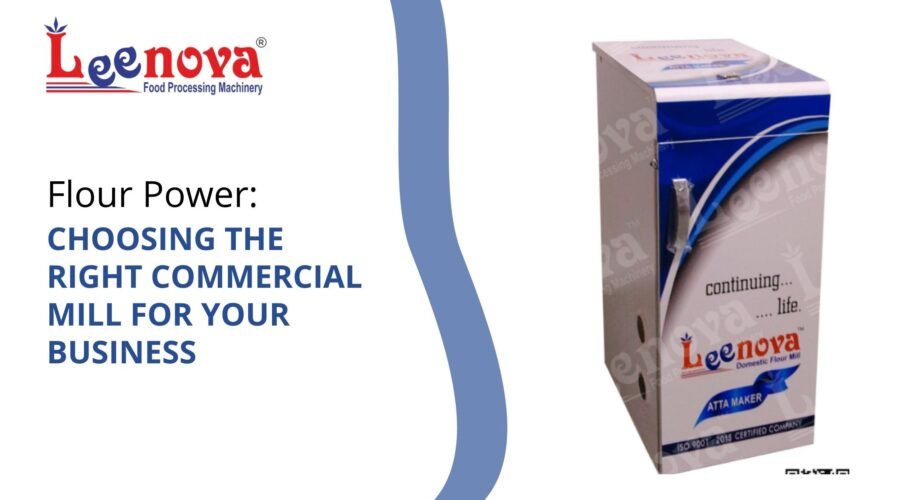Introduction
Buying flour from the market works—until it doesn’t. Inconsistent fineness, warm flour that stales early, and supply hiccups show up in your dough and your margins. A commercial mill fixes that by giving you repeatable grind, cooler output, and control over daily volumes. This guide shows you how to pick the right machine for your menu, space, and power supply. We’ll size capacity, compare mechanisms, decode specs, and flag real-world traps like heat, dust, and maintenance. Follow the steps, make a shortlist, and test with your own grains before buying.
Leenova Kitchen Equipment designs and manufactures commercial flour mills, pulverizers, and allied kitchen equipment for Indian kitchens and small processing units.
Who it’s for
- Bakeries & QSRs: fine atta/maida for predictable dough hydration.
- Cloud kitchens: multi-grain menus with quick changeovers.
- Kirana grinders & micro-mills: uptime, dust control, and low cost per kilo.
- Catering units: medium-fine flour with tight prep windows.
If you handle wheat plus rice/maize/pulses, plan for mesh swaps and cleaning time. Your process—not the brochure—decides the right machine.
Capacity planning
Goal: match daily demand without running the mill at redline.
Three-step planner
- Compute target rate: daily kg target ÷ milling hours = required kg/hr.
- Add headroom: +20–30% for mesh changes, cleaning, and operator breaks.
- Size for peaks: Diwali/Ramzan weekends and school seasons matter more than Tuesdays.
Example: 180 kg/day in a 6-hour window = 30 kg/hr. Add 25% → aim for ~38 kg/hr real-world capacity.
Mechanism types (texture, heat, and noise)
- Stone (emery) mills: traditional mouthfeel for chapati/atta. Lower RPM, good for flavor; needs dressing/replacement over time.
- Impact/micronizer (stoneless): high RPM beaters/liners. Fast, versatile for rice/maize/pulses; can run warmer; sieve controls fineness.
- Dual-stage / double-chamber: staged reduction for tighter particle spread at higher throughputs.
- 2-in-1 (flour + masala): flexible, but cleaning discipline is non-negotiable.
Rule of thumb: if wheat texture is king, evaluate stone. If you run mixed grains and need speed, evaluate impact/dual-stage.
Power and electricals
Power quality decides performance and motor life.
- Phase: single-phase is fine for light duty. For longer windows or 7.5–10 HP class, three-phase runs cooler and steadier.
- Start-up load: confirm proper MCB/overload protection; avoid undersized wiring.
- Stabiliser/AVR: recommended in voltage-fluctuation zones (common in many Indian cities and towns).
- Efficiency metric: track kWh per 100 kg, not just “units/hour.” It exposes drift in both process and machine.
Place mills with ventilation. Warm flour shortens shelf life and dulls aroma.
Build, hygiene, and maintenance
The best mill is the one your team can keep clean.
- Access: tool-less or quick-tool access to chamber and discharge.
- Hygiene surfaces: food-grade contact parts; finishes that wipe clean.
- Dust control: cyclone/collector to keep air and floors clean.
- Vibration: balanced rotor and pads protect bearings and operator comfort.
- Spares kit: belts, common meshes, and wear parts on site—saved many prep shifts.
SOP cadence (starter pack)
- Daily: wipe-down, empty residue, quick sieve check.
- Weekly: deep clean, fastener check, belt alignment.
- Periodic: stone dressing or beater/liner inspection; bearings and seals.
Specs that matter (and how to read them)
Use the spec table like a checklist, not a poster.
- Motor/HP & RPM: HP ≠ throughput by itself; chamber geometry and RPM shape output and heat.
- Phase/Voltage: confirm supply available at your site; plan the plug point and cable gauge.
- Capacity (kg/hr): treat as a band. Grain hardness, moisture, and mesh move the number.
- Chamber/Cutter/Liner: higher build quality = lower vibration and steadier fineness.
- Build (MS vs SS): MS powder-coat is rugged and value-led; SS is audit-friendly and wipes down faster.
- Power use: ask for typical kWh per 100 kg by grain and mesh.
If a vendor won’t share mesh options or cleaning time, don’t guess—insist on a demo.
Heat, fineness, and real-world output
Two batches, same machine, different outcomes—that’s normal.
- Mesh drives texture and kg/hr. Finer mesh slows throughput; plan timing accordingly.
- Moisture is a silent spoiler. High-moisture wheat or humid rooms raise temperature and clumping.
- Feed discipline matters. Over-feeding spikes heat and hurts uniformity.
- Cooler grind = better flour. Expect better dough handling, color, and shelf life.
Quick test: time three 10-kg runs at your target mesh; measure flour temperature at discharge; log energy used. You’ll know if the spec fits.
Budget, warranty, and service
Sticker price is only the opening bid.
- What moves price: HP, chamber design, cyclone, body (MS/SS), sieve kits, logistics.
- Warranty clarity: duration and response time. Who picks up the phone?
- Service reach: city-wise coverage or partner network; preventive visit options.
- TCO view: energy, wear parts, downtime, and operator time. A “cheaper” mill that runs hot or vibrates costs more mid-year.
Where possible, negotiate a pilot/demo using your grains and mesh. Pay for certainty, not adjectives.
FAQs
Q1: Can one mill handle wheat, rice, and pulses?
A: Yes, with the right mechanism and mesh set. Expect different throughputs by grain. Plan changeovers with a written cleaning sequence to avoid cross-contamination.
Q2: Do I need a foundation?
A: Usually no. A level floor with vibration pads works for most small and mid-size mills. Check weight and anchoring guidance in the manual.
Q3: How many meshes should I keep?
A: Start with three that match your menu: fine chapati, medium all-purpose, coarser blend. Label and store them; train quick swaps.
Q4: Is cyclone collection worth it?
A: If you care about air quality, cleanup time, and yield, yes. Many Indian shops choose cyclone once daily volumes pass ~100 kg.
Q5: When should I choose three-phase?
A: If you run 7.5–10 HP, mill for long windows, or your area has voltage drama, three-phase pays back in stability and motor life.
Conclusion
Choose by math, not by adjectives. Define daily kg, add headroom, match mechanism to grains, verify power and hygiene, and compare kWh per 100 kg on your own test runs. Then buy the machine that stays cool, stays consistent, and stays easy to clean.
Leenova Kitchen Equipments builds commercial mills for Indian conditions—hygiene-first design, practical changeovers, and responsive support. Request a demo or quote tailored to your grains, mesh, and power supply, and make your flour a competitive edge.


